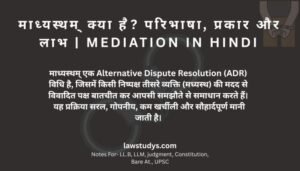Hello friends, in this article the ancient judicial system of India. Hindu law prevalent in India before the arrival of the British. The Indian judicial system before the arrival of the British and the ancient judicial system of the Hindu period have been mentioned. Hope you will like this article –
Introduction – Ancient judicial System
Before the arrival of the British rule, there is sufficient information available in the ancient religious texts of India about the judicial system of then India.
In ancient times, religion was given more importance, due to which Andhikash laws were tied to religious rules and due to this, India’s ancient Vedas – Puranas, Shastras, Upanishads etc. are considered to be the basis of the then law on which the judicial system of ancient India was based. Has made significant contribution.
In the ancient legal system, more emphasis was given on morality to follow the law. Before the arrival of British i.e. at that time, Andhikash Vidhi was in Sanskrit language so the general public could not understand it much and with the change in circumstances with time, there was a lot of difference between the original Vidhi and the present Vidhi.
If we compare the provisions of ancient Hindu law with the ancient Vedas and Smritis, we will not see any similarity in each other. Apart from this, the method of ancient Hindu period is mostly based on the then customs, traditions and customs.
Read Also – What is Criminology : Introduction, Definition, Importance
Ancient judicial system of Hindu period –
In the ancient judicial system of Hindu times, the complete responsibility of justice and punishment rested on the ruler. At that time, there was a belief that the king is a part of God (Divine Right of King) and since the justice given by the king is according to the divine will, his orders should be followed.
Due to the emphasis on religious observance and moral conduct, most people followed religion and generally stayed away from misdeeds or crimes.
As a result, the law and the punishment system based on it were necessary only for those who committed misdeeds. The desire to attain heaven or salvation after death encouraged people to lead a virtuous life.
The king or ruler was expected to punish law violators and criminals as per public policy. Every person was required to perform his duty towards the society otherwise he was punished for not performing his duty.
Read Also – Description of the Scope and Nature of Criminology
Vedic period and Smriti period –
The principles of law are mentioned at some places in the Vedas. Rituals had special importance in the Vedic period. If there was a contradiction between the Vedas and the Smriti on any subject, then the system given in the Vedas was acceptable and the corresponding system given in the Smriti was invalid.
But since the Smritis were composed in the later period of the Vedic period, their importance from the point of view of practical method was considered more than that of the Vedas.
The form of legal system of Smriti period is found in Dharmasutra, Dharmashastra, Puranas and Gathas etc. Memories have been considered authoritative by the courts. Theologians like Manu, Yajnavalkya, Narada, Brihaspati and Katyayana tried to compile all the rules related to law in self-written theology.
Especially Manusmriti and Yajnavalkya Smriti have an important place from the legal point of view.
There is no clear distinction between the principles of religious, moral and common law in the Smritis because at that time religion, morality and law-observance etc. were all based on the duties of man. But there are many examples which confirm that the Smritis were aware of the differences between religious, moral and common law.
Over time, under the patronage of Hindu rulers, scripture writers wrote commentaries on these Smritis, whose basic objective was to get the legal arrangements given in them officially recognized in the judicial institutions so that they could be used in adjudicating cases. Among other major commentators of Smriti, Dhareshwar’s commentary on Manusmriti, written in the eleventh century, is famous.
Read Also – What is the Schools of Criminology And how many Types are there? – Criminology
In Hyderabad, under the patronage of King Vikramaditya of Kalyan, the famous commentary Mitakshara on Vijnaneshwar’s Yajnavalkya Smriti was written, which is the birthplace of the Mitakshara branch of Hindu law. A detailed discussion regarding behavior and religious conduct is given in the ‘Todarnama’ of Akbar’s revenue minister Todar Mal.
Ancient times –
Apart from the Vedas, Smritis and their commentaries, the reflection of the ancient legal system is also visible in the Puranas. Although there are many Puranas but the main ones among them are the eighteen Puranas written by Ved Vyas which are famous as Mahapuranas.
Ancient stereotypes –
The customs, customs and traditions prevalent in ancient India had an important place in Hindu law and have been recognized as major sources of religion. The courts have also considered conventions to be superior to the law.
In Ramnad’s case the Privy Council held that “the weight of clear evidence of custom is greater than that of the written text of the law.” Stereotypes have a direct relation with the common people.
Read Also – What is Public Interest Litigation? and its importance in India
The practices themselves are well organized and their prevalence among the general public is in itself a proof that the society is willing and ready to accept them. In the form of law, practices have a more important place than the Vedas and Smritis because the Vedas are considered God-given and the Smritis are considered based on divine words.
The sages did not remember some parts of the religious instructions given by God, but they adopted them in practice, which over time became established as customs or practices.
Mimamsa, commentary and essay –
Mimamsa scriptures also had an important place in the legal system of ancient India. In these, the controversial parts of the Shrutis are presented as problems and their conclusions are given in the form of answers.
The summary is that explanations of many problems of Hindu law are available in the sutras written by Mimamsakas. Among the Mimamsakas, Kumaril Bhatt, Madhvacharya and Bhagwan Upavarsha etc. are prominent.
According to Manu, only Shruti and Smriti were the main authentic sources of ancient law, but due to change of times and progressive development of law, study of other sources also became mandatory.
The legal rules given in the Smritis are the original scriptures and these Smritis have been commented upon or explained in the commentaries. In the essays, the texts of many Smritis on a particular subject have been quoted and written in the form of an essay so that the method in that regard becomes clear.
According to Max Muller, in the ancient Indian legal philosophy, maximum emphasis was given to Dharma, Karma, Artha and Moksha in human conduct in which the intervention of the ruler was minimal because the subjects themselves were aware of their duties and responsibilities.
Kautilya’s Arthashastra –
The contribution of Kautilya’s Arthashastra to the Indian judicial system is unprecedented. Since economy is related to the prosperity of human life, it has always been closely related to state administration and law and order.
Historically, Arthashastra was composed during the Dharmashastra period of ancient India. But the most important contribution in this field has been that of Chandragupta Maurya’s minister Kautilya (Chanakya).
In Kautilya’s Arthashastra, detailed legal rules have been given for good governance, political maneuvering and discipline.
Kautilya, considering Dharmashastra as the base pillar, considered the king as the fountain of justice and expected the ruler to protect his subjects with motherly feelings. Since ancient religion was based on duty, there was no place for discrimination on the basis of caste, religion, sect etc. (Read – Kautilya’s Arthashastra)
Related Post –
Ideology of Criminology and its different types | Criminology Notes




